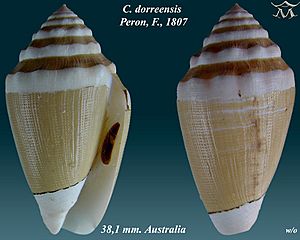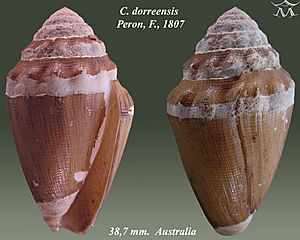Conus dorreensis facts for kids
Quick facts for kids Conus dorreensis |
|
|---|---|
 |
|
| Apertural and abapertural views of shell of Conus dorreensis Peron, F., 1807 | |
 |
|
| Scientific classification | |
| Synonyms | |
|
Conus dorreensis, often called the pontifical cone, is a type of sea snail. It is a marine mollusk that belongs to the Conidae family. This family includes all the different cone snails and their relatives.
Just like all species in the Conus group, these snails are hunters and are venomous. This means they can "sting" humans. Because of this, it is very important to handle live cone snails with extreme care, or even better, not at all.
What Does the Pontifical Cone Look Like?
The shell of the pontifical cone snail can be quite small, ranging from about 11 millimeters (less than half an inch) to 48 millimeters (almost 2 inches) long.
The top part of the shell, known as the spire, is raised and has small bumps on it. The entire surface of the shell is covered with very fine lines that go around it. These lines also have tiny, punctured dots.
The outer layer of the shell, called the epidermis, is usually a yellowish-olive color. This layer is very thin. It often stays on the main, wider part of the shell as a broad band. However, it is usually missing from the narrow top and bottom parts of the shell, which are white.
Where Do Pontifical Cones Live?
This marine snail is found only in Australia. It lives off the coast of Western Australia.
Images for kids



